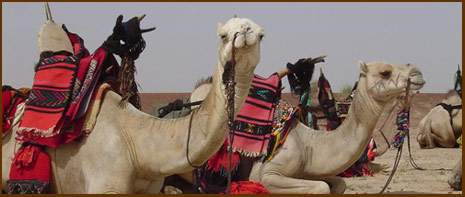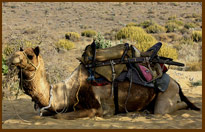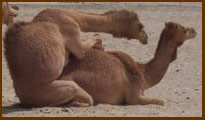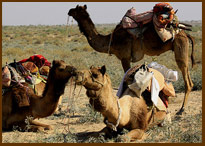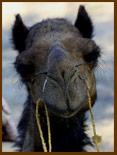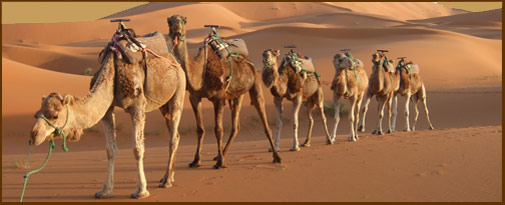Camel
Introduction
Page 1 of 6
The Indian Camel or dromedary camel with the zoological name "Camelus dromedarius" is one of the camel species present in India with a single hump.
It is of the order Artiodactyla and the family Camelidae. There is another subspecies of the camel named "Bactrian Camel" (Camelus bactrianus) existing in the parts of central and East Asia with two humps.
It is a domesticated animal and often called as "The Ship of the Desert" or "The Beast of Burden". The term "Camel" is derived from an Arabian word signifying beauty.
Physical Structure
The Indian or dromedary camel is an even-toed hoofed animal and it distinguishes from other camel species with its single hump containing fatty materials, long-curved neck, and deep narrow chest. The light brown colored hair seems to be longer on the throat, shoulder and hump when compared to other the parts. The herd of camel may consist of one male, one or more females and their young ones. The herd count may vary from 2 to 20.
The humps are believed to store water which is absolutely false and it's just a reservoir to store fatty deposits. The fat present in the hump helps the animal to minimize the heat spreading throughout the body which makes their life feasible in the desert regions. The heat trapped by this causes metabolization and acts as a main source of energy and yields 1g of water for each 1g of fat by the reaction with oxygen present in air.
The thick fur present all over the body is another adaptation that helps them to live in desert areas. Their ability to survive long periods with less amount of water is due to a sequence of physiological adaptations unlike other mammals. Their cells are structured in such a way to adapt such physiological changes.
Page 2 of 6
Camels have the capability to bear high temperatures ranging from 34 °C (93 °F) during night time and 41°C (106 °F) during the day time.
The evaporation for camel takes place at the skin level which cools their body and reduces the water loss through sweating.
Their nostrils are so characterized in such a way that they absorb more amount of water vapor from the air and thereby reduce the dehydration through breathing.
Their long legs with soft pad on their foot act as a pair of snow shoes and help to bear the heat on the hot sands. Their mouth helps to chew thorny plants available in the desert. Long eye lashes and the ear hairs avoid the sand entering into their nose while eating. The kidneys and intestines are very efficient in retaining water for long hours. Because of all these factors the camels could store five liters per day. Their faeces are used as fuel fires by the desert people.
Indian camels are 6 to 6.5 ft (1.8 m to 2 m) tall with the body weighing about 250kg to 680kg (551lbs to 1500 lbs). Its tail is 50 cm (20 in) long. The hump goes upto 30 inches
out of its body. They are good runners in sand and the speed rate varies from 40 km/h to 65 km/h. Their various uses include milk, meat and as a caravan, carrying goods and people over long distances.
Distribution and Habitat
India Camel is typically found in the north and north Western part of India especially in Thar Desert, the desert of Rajasthan. They are capable of living in desert regions and dry arid regions of India. They can be seen in group with the count ranging from 2 to 20 camels. The male is the prevailing member of the group and directs its family from the back end and the females lead the group.
Places Found
Desert National Park: Desert National Park is located in the Thar Desert area, the Great Indian Desert located in Rajasthan. It is one of the largest national parks covering an area of about 3162 sq.km. It has an excellent ecosystem with the majority of camels and the other animals like Desert Fox, Bengal Fox, Desert Cat, Wolf, hedgehog, Black Buck and Chinkara. Camel Safaris are arranged to view the biodiversity of the park.
Sariska Tiger Reserve: The Sariska Tiger Reserve is a national park in India located in the Alwar district of Rajasthan. The park is situated at a distance of 107 km from Jaipur and 200 km from Delhi. This area was a hunting reserve and it was declared a wildlife reserve in 1955.
Page 3 of 6
In 1978, the park was given the rank of a tiger reserve making it as India's Project Tiger system. The current area of the park is 866 kms.
Most commonly spotted carnivores here are leopard, Bengal tiger, wild jackal, wild dog, sambhar, chital, hyena, wild cat, nilgai, wild boar, camels, etc. Camel Safaris are arranged to view the biodiversity of the park
Bharatpur Bird Sanctuary: Bharatpur is located on the outer edge of the Thar Desert. It is the sanctuary mainly for birds having an area of about 29 sq.km. Some rare fauna there are Sambar, Chital, Nilgai and Boar. Camel safari tours to view the grasslands and the habitats of the park are awe-inspiring. Apart from all the above places they can be found in and around the Thar Desert area to help visit the desert.
Food HabitsIndian Camels are herbivorous animals. Their food habits may include dry grasses, herbivorous diet consisting of thorny bush, dry grasses, grains, wheat, oats, dried leaves, seeds and other available food in desert. They can survive for days without having a sip of water.
Other Species of Camels:
1. Camelus bacterianus: The Bactrian camel (Camelus bactrianus) is a large two-humped animal, even-toed ungulate, native to the North and central Asia, found in Gobi and Taklamakan Deserts of Mongolia and Xinjiang.
The other species like Syrian Camel, Camelus gigas, Camelus hesternus, and Camelus sivalensis have been extinct.
Mating Behaviour:
The mating occurs in the male and the female camel on a seasonal basis. The camel attains puberty at the age of 4 to 5 years. The sexual activity starts at 2-3 years but ovulation is induced only at the age of 5 years.
Page 4 of 6
The cycle lasts for about 27 days to 30 days depending on the nutritional level of the female.
Their gestation period varies from 12.5 months to 15 months depending on the season, food, stress and other factors. They can give birth to 1 offspring at a time and at rare cases they can yield twins. The offsprings eyes are opened and have the thick woolly coat with no hump. The off springs weigh about 30-40 kg (66-88 lbs).
The female and its baby lives together for several years and they are weaned till one year of age.
The lactation capability of the female is 20-25 litres (5.28-6.6 gal) of milk a day and the healthy females can produce 30-40 liters(8-10.6 gal) a day. They may stay with their mother for about two years or till they attain maturity. They may give birth every 2-3 years thereby producing 8 calves by the age of 20. The single male camel tries to attract many females and start their mating.
Benefits of Camel
1. Camel's milk is used for dairy purpose to prepare yogurt, butter, cheese etc.
2. The meat of Indian camel may range from about 250 kg to 400 kg. Since the camel's milk is low in fat and cholesterol people show interest to kill camels for their meat.
3. The camel's urine is believed to have some medicinal purpose.
4. Majorly used as a form of transportation in desert areas.
Population of camel in India:
India stands third in the Camel population after Somalia and Sudan with the population of about 1.520 million during 1990 and the majority are seen in Rajasthan. The population seems to be decreasing because of the camel's unhygienic conditions. Since they are used to travel long distances without proper food and water their count has fallen. The estimate in 2005 revealed that India had only six hundred thousand camels. In national parks, the grazing is not possible as there is less amount of grasses and the climatic change is contrary with their adaptable conditions. These factors make their life not feasible in parks.
Threats to Indian Camel and the Conservation Effort in India
Although there is no major threat to the Indian camel, there are few unknown threats which we should be aware of.
Page 5 of 6
The camels are killed for their meat, their skin, hair and bone because of their distinct usage.
Camels are used above its capability level in order to carry heavy goods, peoples along long distances which may lead to unhygienic conditions.
A volunteer organization with the group named "Help in Suffering" based in Rajasthan has come up with the initiative to take care of the camels by arranging animal shelters and to provide medication for the injured and unhygienic camels. Ambulance with devices are arranged to carry the heavy camel to the veterinary hospitals.
Mythology behind camels
There are many mythologies behind the camel in various puranas and folk tales. According to the Markandeya Purana, the camel is said to be the inferior species since it was born out of the feet of Brahma. Lord Virupaksha (an incarnation of Lord Shiva) rides on his carrier, which is a camel (Mahamohastaivoshtraha Katithasthasya Vahanaha) which is said in the Visnudharamottara Purana.
Ushtravahini Devi or Untadevi, the female deity riding the camel is worshipped in some parts of India, especially in Rajasthan and she is in fact the family deity for the Puskarna Brahmins living in Rajasthan. Saanda Mata, whose carrier is also a camel, is worshipped by most of the tribal people of Udaipur.
Camel as a symbol in various religions
In India, Camels are seen as a symbol of humbleness, willingness to serve and bear other's burden. In Egypt camels are the symbol of Lord Allah who makes them survive in the hot deserts. The Christians in Jerusalem depict Camel as a symbol of wealth, since it helps nomads and the merchants for transportation in deserts.
Camel is the National Animal of Kuwait
Interesting Facts
Page 6 of 6
1. In 10 minutes, the dromedary camel is capable of drinking 100 liters of water
2. They can carry upto 90 kg weight to about 32 km at a stretch without food and water.
3. As their first letter 'D' the Dromedary camels have a single hump with the 'D' shape.
4. 50,000 camels meet on the tiny desert for Pushkar Camel Fair, in the town of Pushkar located in Rajasthan. This contest takes place for five days and the camels are dressed for their beauty contest and trade.
5. Now the dromedary camels are used for cavalry and as freight animals like horses and mules.
6. Camel milk is the only food for desert nomad people and is richer in fat and protein than cow's milk.
7. Camel milk is believed to have many beneficial properties and is used as a medicinal product in India.
8. Camel racing is a popular sport in various areas like Saudi Arabia, Bahrain, Qatar, United Arab Emirates, and Australia.
9. Their average life span may vary from 40 to 50 years.
10. The hump size for each camel may vary based on their nutritional status.
11. They can run upto 65 km/h at a stretch and maintain 40km/h while covering long distances.
12. The size of hump varies depending upon the supply of nutrients.
13. Usually the camels avoid stony deserts, as the stone harms their feet.
14. When the camels are frustrated, distressed or angry they spit a fetid stream which is formed in its first stomach chamber.
15. Camel fair is conducted every year in the month of October and November in Puskhar, India wherein the trading of camels, parade and fancy competition takes place.
